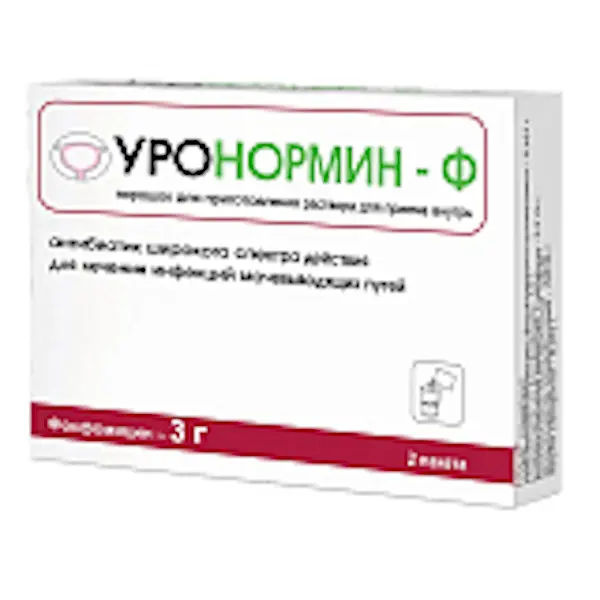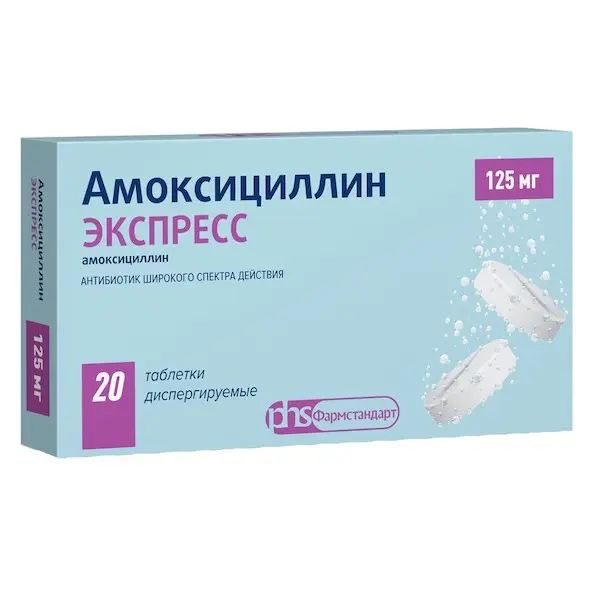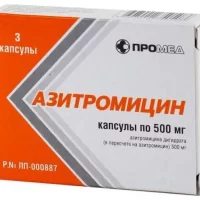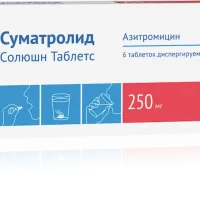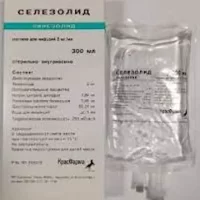Description
Uronormin-F Pharmacodynamics
URORMIN-F contains phosphomycin [mono (2-ammonium-2-hydroxymethyl-1,3-propanediol) (2R-cis)-(3-methyloxyranil) phosphonate] – a broad spectrum antibacterial agent, derived from phosphonic acid, intended for treatment of urinary tract infections.
The mechanism of action is associated with inhibition of the first stage of synthesis of the bacterial cell wall. Being a structural analogue of phosphoenolpyruvate, it competitively inhibits irreversibly the enzyme UDF-N-acetylglucosamienolpyruviltransferase, which catalyzes the reaction of formation of UDF-N-acetyl-3-O-(1-carboxyvinyl)-D-glucosamine from phosphoenolpyruvate and UDF-N-acetyl-D-glucosamine. The drug is also able to reduce bacterial adhesion to the bladder mucosa, which may play the role of a predisposing factor for recurrent infections. The mechanism of action of the drug explains the absence of cross-resistance
with other classes of antibiotics and mutual potency with antibiotics of other classes, such as beta-lactam antibiotics.
Fosfomycin is active against a wide range of Gram-positive
and gram-negative microorganisms commonly isolated in urinary tract infections, such as Escherichia coli, Citrobacter spp., Klebsiella spp., Proteus spp., Serratia spp., Pseudomonas aeruginosa, Enterrococcus faecalis.
The emergence of resistance under laboratory conditions is explained by mutations
of the glpT and uhp genes that control L-alpha-glycerophosphate transport
and glucose-phosphate transport, respectively.
Indications .
Infectious and inflammatory diseases caused by phosphomycin-sensitive microorganisms:
– Acute bacterial cystitis, acute attacks of recurrent bacterial cystitis;
– bacterial nonspecific urethritis;
– Asymptomatic massive bacteriuria in pregnant women;
– postoperative urinary tract infections;
Prophylaxis of infections during urinary tract surgery and transurethral diagnostic examinations.
Contraindications
– Hypersensitivity to phosphomycin and other components of the drug;
– severe renal insufficiency (creatinine clearance < 10 ml/min);
– children under 5 years of age (for 2 g dosage), children under 12 years of age (for 3 g dosage);
– hemodialysis;
– sucrose/isomaltase deficiency;
– fructose intolerance;
– glucose-galactose malabsorption.
Administration during pregnancy and lactation
During pregnancy, the drug is administered only when potential benefit to the mother exceeds the potential risk to the fetus. The data of limited number of pregnancies studied do not show any undesirable effects on pregnancy, fetus or health of a newborn.
If it is necessary to prescribe the drug during breastfeeding, breastfeeding should be stopped for the period of treatment.
Dosage and administration
- Inside.
- The powder is dissolved in ½ cup of water (50-75 ml) or other beverage, stirred until completely dissolved, take immediately after dissolution. URONORMIN-F is used once a day orally on an empty stomach 1 hour before or 2-3 hours after a meal, preferably before going to sleep, pre-bladder emptying.
- Adults and children 12 to 18 years: 1 sachet (3 g) 1 time a day.
- To prevent urinary tract infection during surgery and transurethral diagnostic procedures, fosfomycin is taken 2 times 3 g: 3 hours before the intervention and 24 hours after the intervention.
- For children from 5 to 12 years old: 1 sachet (2 g) once a day. In order to prevent urinary tract infection during surgery and transurethral diagnostic procedures fosfomycin is taken 2 g 2 times: 3 hours before the intervention and 24 hours after the intervention.
- In more severe cases (elderly patients, recurrent infections) another 1 sachet is taken 24 hours later.
- No dose adjustment is required in patients with mild to moderate renal insufficiency.
- The drug is contraindicated in patients with severe renal failure or those on hemodialysis. No dose adjustment is required in patients with hepatic impairment.

